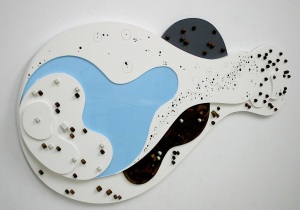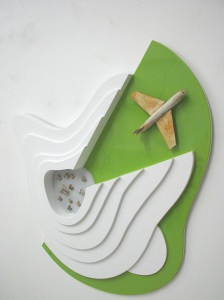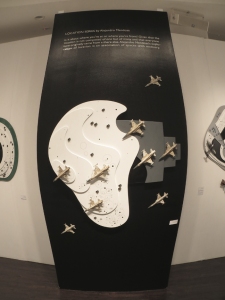Is it about where you’re at or where you’re from? Given that the location is not composed of one but of many and that everyone here originally came from a there else, Alejandro Mendoza’s exploration of location is an association of spaces with memory.
Locations present a mental geography that maps and orders the location, human relations and the mind. The physical and conceptual layout of the location encompass the structure and order of Mendoza’s work and construct the lines and dots positioned upon as pathways, detours, exits, entrances, rebounds, acceptations, appropriations and identifications that characterize the active social process of movement From there to here. Location is then the outcome of dis/re/relocation’s that provoke manner of reflections on the consequences for a sense of belonging or unbelonging arising from the crossing of “routes and roots”. This association of routes and roots is “topoanalysis”—-spaces associated with memories, thus can be ‘read’ as a psychological diagram of a subconscious.
Alejandro Mendoza provides a visual vocabulary that signals the recognition that the transactions of peoples brought together From there to here result in profound disruptions and adjustments that require an active process of forging new identities. Location, location, location then prompts to ask: What does the artworks, and expressive forms generally, tell us about this process that exceeds what analytical and historical accounts by themselves can reveal? Are there more general lessons to be learn here about the problematic of subjectivity, particularly regarding the role of affect? And are these the forms through which identities and ways of life can be re-figured?
For Mendoza, it is through the activities of recalculating/calibrating that locations are transformed into place of meaning. The works presented here provide cues for finding adequate formulas.
The thematic of space is intimately linked to that of time and experience in Town over. It is through space that the encountering of the other is accom-plished. The space “location” functions as a kind of palimpsest, “a kind of parchment on which successive generations have inscribed and re-inscribed the process of History.”
We see the town in an aerial map composed as a puzzle of pieces of wood. The usual perspective, which obliges us to look above through a monoculture, cultures from somewhere else, finds itself inversed. The entire town becomes a projection of piecing of cultures. The town is recomposed in a complete and harmonious manner by the plethora of identities expanding infinitely through the process of mixing.
Space is also a theme with multiple facets in the work of Alejandro Mendoza. It is both domestic and geographic. The space through metonymy represents all the problematic of history, of movement— dis/re/location as in Town over, the location becomes the reflection of the condition of those that inhabit it.
As the location series, Mendoza is in search for a window, a frame allowing seeing his own life and our society in which We are helping People. The work of Mendoza is thus linked to all that concern the eye, the sight, and the arts in search for an aesthetic fitting to his world, to the reality of the contemporary world.
Mendoza’s linguistic sensibility makes ambiguity rather objectivity the ultimate target of its contemplation.(Pau-Llosa). The aircraft carrier deck –like and the fighter jets on it in We are helping people provide cues for Mendoza’s keen awareness of another possible world. Instruments of war, Mendoza flip them over for an expression of a deep-seated human quality.
We help people calls for forgetting war. It is a bridge we need to cross for our wish to materialize. The aircraft carrier no longer exists as the ultimate recourse through death. Thus, all that remains, here and there, is a bloody twisting of the human spirit which he denounces and which we must eradicate. Only confusion makes us mistake a wink for a wink, leading us to take the map for the territory.
This approach for a new intelligibility which graft Ricardou’s literary fiction analysis is relevant to the overall philosophy of art and could, if proved, or rather revealed itself be operative to access an “intelligibilité nouvelle.” Mendoza views this intelligibility in asymmetrical dimensions. But!
This asymmetry is neither obvious nor easily detectable, especially as the old perceptual habits make us see all in symmetries, equalities and balances as if they constituted the essence of things, beings, the entire universe and the condition of their intelligibility. So,
Be my Blue! De-shaping has been constant in Mendoza’s recent conversations. This perhaps explains the fluidity of his lines and their asymmetrical jet as to reinforce the permanent movement of his thinking— a never conviction of having arrived at…but always in becoming.
Dissymmetry and inequality then are actually everywhere: in reality and in thought, things, beings and in art. The difficulties of the theories of imitation and the inability of imitative artists to realize the symmetries and equalities in perfect reproductions of natural patterns, bold and fanciful forms of abstract art and cubism, deformations and distortions of African art, contemporary architecture, are all examples of the reality and permanence of asymmetry in the works of civilization. An artist who creates mindfully cannot simply be as s/he appears. Thus, although order, harmony and balance requirements are of the mind constituted habits , it is necessary to be convinced that the traditional concept of beauty has become too narrow to reflect and cover the semantics field of esthetic.
The issues invoked above pose the fundamental question of identity in its personal and collective dimensions. Mendoza expresses the paradoxical nature of the response he brings to the conceptualization of the “other” which is at the center of cultural studies. The metaphorical shape of The others does not allow solving the dilemma of internal division that affect the migrant subject. To the contrary, it suggests an infinite refraction of that division, that crack which leaves the subject divided between his/her submission to the gaze of the other and his/her desire to be whole, finally master at home, capable of generating his/her own definition of his/her identity. The others can then be read at the levels of vision/division/visibility/invisibility.
Division is the negative side of the question. The traces of this thematic are to be explored because through his work, Mendoza often invokes these breakings that cross the othering process; division between the colonizer and the colo-nized, between black and white, between past and present rendering the subject paralyzed by the gaze of the other, flabbergasted by a gaze that forces him/her to see him/herself as others see him/her. The expropriation is not uniquely geo-graphic; it’s above all identity.
The border, of difference and similarity, between self and others is a strainer through which historical facts are negotiated in remembrance, obsolescence, and dynamics of signification of representations. The border functions as a mode of inscription through mnemonic codes that delineate the temporal and realities of a community in term of visual imagery
Emphasizing the border as place/location offers an importunate signal for exploration of the concept of “place memory”. But the signs of division are several and always inextricably linked to their contrary, in search for that freedom in which all forms of binary and duality fly across the border.
In this paradoxical relationship between division, tearing and search for an impossible wholeness, the works of Alejandro Mendoza occupies a key position. They are a form of doubling by which they remain themselves while bearing the mask of another possible identity. The vision doubles in hope of increasing the visibility of the objects of this world. This doubling is enrichment, supplement of sense. The artistic language of Mendoza is often “ambiguous” —the mark of a vision that is all but linear. His forms are rather related to rhizome often invoked to describe the logic of the transnational world. The equilibrium is always instable and needs the energy of experiences of crossing borders, helping people and finding new locations.
Babacar MBow
Art Critic/Curator
April 5, 2012, Miami, FL





